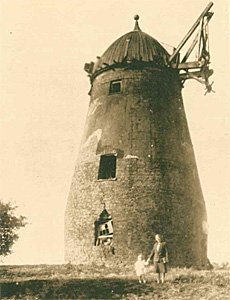Houghton Conquest WIndmill

Houghton Conquest windmill in 1931
(from a Bedfordshire Historical Record Society publication on windmills)
The first mention of a windmill at Houghton Conquest is in 1741 when the Manor of Houghton Conquest was conveyed by Benedict Conquest to John, Baron Gowran [RO5/302-303]. The structure, forming part of the manorial lands, was described as a messuage “nor or heretofore a windmill and a little close adjoining” of one and a half acres.
![Houghton Conquest windmill in 1809 [MA69-2]](/CommunityHistories/HoughtonConquest/Houghton-Conquest-Images/Houghton-Conquest-windmill-in-1809-MA69-2.jpg)
Houghton Conquest windmill in 1809 [MA69/2]
Volume XIV published by Bedfordshire Historical Record Society in 1931 includes an article by J Steele Elliott on Bedfordshire windmills; he has this to say of Houghton Conquest: “1809. On the Award Map of this date [MA69] there is a fine miniature sketch of a post-mill, supported by the post and brace timbers”.
“A windmill is first mapped in this same locality in 1826 [Bryant’s map of Bedfordshire]. It is a brick tower-mill of unusual shape and massive proportions, and at one time was roughcast. It is approached by a by-lane, and stands at Brook Farm on rising ground at Duck End, fully half a mile north of the Church. The ground floor is built with a perpendicular wall, which here tapers above, but at Dunstable is perpendicular through another floor. The tower stands 35 feet in height to the top of the ball terminal, and has 30-inch wall footing. The wooden cupola is interestingly ribbed, and so differs from any other local example. The mill was last used about 1910. The sails were originally for cloths, but about 1877 a heavy gale blew away the sails with the mill head into the adjoining field. The cloths were then exchanged for shutters, and a fan-tail fitted for heading the sails to the wind. The sails were eventually sold, and were removed to Cranfield Mill about a year after they ceased working. There were three floors and three pairs of stones. The mill property has been for three generations in the ownership of the Chesher family (probably descendants of the family already recorded at Barton) but was sold in 1930. The grandfather, it is said, helped to build the present mill when a youth; this would date back its erection to early in the 19th century. It stands on an artificially raised site in the field, and confirms that the earlier post-mill occupied the same position”.
The Rating and Valuation Act 1925 specified that every building and piece of land in the country was to be assessed to determine its rateable value. The valuer visiting the old mill house [DV1/C78/81] found it owned by Miss Cheshire [sic Chesher] and occupied by Francis Day whose rent was £35 per annum, which included a field of 11.547 acres.
The house comprised two reception rooms, a kitchen and scullery with four ebdrooms upstairs. Farm buildings were: a timber and tiled hovel, barn, store, cart shed and coal barn, the old mill and “sundry sheds”. Water came from the Camel Beerhouse. The valuer commented: “Old Farmhouse very nice little garden”.
The ruined mill is still extant at the time of writing [2016]. It lies just north of the far end of Mill Lane.